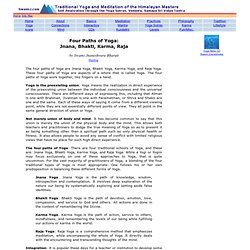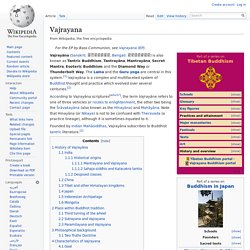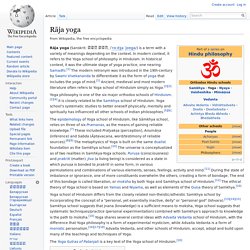

Sadhana. The historian N.

Bhattacharyya provides a working definition of the benefits of sādhanā as follows: Iyengar (1993: p. 22) in his English translation of and commentary to the Yoga Sutras of Patanjali defines sādhanā in relation to abhyāsa and kriyā: Sādhanā is a discipline undertaken in the pursuit of a goal. Abhyāsa is repeated practice performed with observation and reflection. Kriyā, or action, also implies perfect execution with study and investigation. Paths[edit] Anthony de Mello, an Indian Jesuit priest and founder of the Sadhana Institute in Pune, India, wrote a book of Christian meditations with the title Sadhana: A way to God. Traditionally in some Hindu and Buddhist traditions in order to embark on a specific path of sādhanā, firstly a guru may be required to give the necessary instructions.
Kinds[edit] Sakām sādhanā[edit] Niṣkām sādhanā[edit] Vyaṣṭi sādhanā[edit] This is niṣkām sādhanā done for one's own spiritual upliftment. Yoga. Swami Jnaneshvara Bharati Homepage Yoga means to "unite" or "join" the aspects of ourselves which were never really divided in the first place.

It also means to "yoke" or to engage ourselves in a self-training program.
The eight limbs of Yoga. Four Paths of Yoga - Jnana, Bhakti, Karma, Raja. By Swami Jnaneshvara Bharati Home.

Vajrayana. Vajrayāna (Sanskrit: वज्रयान, Bengali: বজ্রযান) is also known as Tantric Buddhism, Tantrayāna, Mantrayāna, Secret Mantra, Esoteric Buddhism and the Diamond Way or Thunderbolt Way.

The Lama and the Guru yoga are central in this system.[1] Vajrayāna is a complex and multifaceted system of Buddhist thought and practice which evolved over several centuries. Founded by Indian Mahāsiddhas, Vajrayāna subscribes to Buddhist tantric literature. History of Vajrayāna[edit] Although the first tantric Buddhist texts appeared in India in the 3rd century and continued to appear until the 12th century, scholars such as Hirakawa Akira assert that the Vajrayāna probably came into existence in the 6th or 7th century, while the term Vajrayāna itself first appeared in the 8th century.
The Vajrayāna was preceded by the Mantrayāna, and then followed by the Sahajayāna and Kalacakrayāna. Tantra. For Tantric Buddhism, see Vajrayana.

For the texts classified as Tantras, see Tantras. Tantra[note 1] is the name given by recent scholars to a style of meditation and ritual which arose in India no later than the 5th century AD.[1] Definitions[edit] Several definitions of Tantra exist. Traditional[edit] The Tantric tradition offers various definitions of tantra. Because it elaborates (tan) copious and profound matters, especially relating to the principles of reality (tattva) and sacred mantras, and because it provides liberation (tra), it is called a tantra.[2] A second, very similar to the first, comes from Swami Satyananda. Tantra embodies two sanskrit words: tanoti (expands) and trayoti (liberates)... Beginning, Intermediate and Advanced Yoga Meditation. Yoga Sūtras of Patañjali. The Yoga Sūtras of Patañjali are 196 Indian sūtras (aphorisms) that constitute the foundational text of Ashtanga Yoga, also called Raja Yoga.

In medieval times, Ashtanga Yoga was cast as one of the six orthodox āstika schools of Hindu philosophy. The Yoga Sutras were compiled around 400 CE by Patañjali, taking materials about yoga from older traditions. Tantra. Swara yoga. Shiva Swarodaya is one of the tantric texts belonging to Hinduism, also termed as Swara yoga by Satyananda Saraswati.[1] It is also termed "Phonetical astrology": the "sound of one's own breath" and is written as a conversation between shiva and parvati.[2] Introduction[edit] The script starts with the conversation between Parvati and Shiva, where Shiva starts introducing the scripts and explaining about the need for maintaining secrecy and also stating astrological value of the text.[3] Its fundamental application is to realize the breath as being the medium of cosmic life force, through practising “Swara Yoga” (special mode of analysis & practising of breath).

According to Mukti Bodhananda, the book enables us to understand nature of breath and its influence on the body as different modes of breathing leads to different types of actions; physical, mental and spiritual.[4] Introduction to swaras and their effects[edit] Pranayama. Pranava yoga. Pranava yoga is a name given to the classical method of meditation outlined in the Upanishads, the Bhagavad Gita, and the Yoga Sutras of Patanjali.

It is also called Aum yoga and Aum yoga meditation. It is, simply put, fixing the mind on the sound of the mantra “Aum” – the sacred syllable that both symbolizes and embodies Brahman, the Absolute Reality – as the mantra is constantly repeated in unison with the breath. Raja Yoga. Rāja yoga (Sanskrit: राज योग, /ˈrɑːdʒə ˈjoʊɡə/) is a term with a variety of meanings depending on the context.

Hatha Yoga, Sun Salutation, Prayer to God, Yogic Prayer, Hatha Yoga workout, Hathayogaway. Kennisgeving voor omleiding. Free yoga videos various free yoga video clips. Yoga Postures Step-By-Step - Index to Poses. Mudras. Karma yoga. Background[edit] The Bhagavad Gita gives a summary of the karma yoga process.[1] The Gita itself is a chapter from the epic known as Mahabharata, wherein a dialogue takes place between the prince Arjuna, and his friend and chariot driver, Lord Krishna, on the brink of a great dynastic war.

Their conversation is prompted by Arjuna as he is engulfed by sorrow and misgivings regarding the oncoming battle in which he has friends and relatives on both sides. In reply, Krishna then elucidates upon a number of philosophical yoga systems and practices (including karma yoga) by/through which he should indeed continue with the fight on righteous principles. Matsya-asana - The Fish Posture - Yoga Postures Step-By-Step.
Tibetian Yoga Masters 3/3. Tibetian Yoga Masters 2/3. Tibetian Yoga Masters 1/3. Meditation. Jnana Yoga Or the Yoga Of Knowledge. Compiled by Jayaram V Generally speaking, the word 'jnana' means knowledge. In Hinduism the word has many connotations. Knowledge is viewed by the Hindu scriptures as both liberating and binding. Knowledge is viewed as the means to achieve certain ends. It can used to fulfill our desires or liberate ourselves. Yogi research. Muktananda. Muktananda (16 May 1908 – 2 October 1982) is the monastic name of an Indian Hindu guru and disciple of Bhagavan Nityananda. Muktananda was the founder of Siddha Yoga.
He wrote a number of books on the subjects of Kundalini Shakti, Vedanta, and Kashmir Shaivism, including a spiritual autobiography entitled The Play of Consciousness. Biography[edit] Muktananda was born in 1908 near Mangalore in Karnataka State, India, into a well-off family. His birth name was Krishna Rau.[1] At 15 he encountered Bhagavan Nityananda, a wandering avadhoot who profoundly changed his life.[1] He studied under Siddharudha Swami at Hubli, where he learned Sanskrit, Vedanta and all branches of yoga, and took the initiation of sannyasa in the Sarasvati order of the Dashanami Sampradaya,[2] becoming Swami Muktananda. In 1947 Muktananda went to Ganeshpuri to receive the darshan of Bhagavan Nityananda. August 15, 1947 Nityananda stood facing me directly. Bhutadamara Mudra. Nuden Dorje Dro’phang Lingpa Tröllö-tsal holds his phurba in the Bhutadamara mudra to display his capacity to dispel whatever needs to be dispelled. Khandro Déchen comments: In this thangka the tail of the tiger is curled behind the hand which wields the phurba.
This confluence of gestures portrays the indivisibility of wisdom and method. The tigress is wisdom and the phurba is method. The same type of symbolism is seen when Yeshé Tsogyel holds her khatvangha – with the tines touching the moon and the vajra terminal touching her sang-né (secret place). The tigress swishes her tail – as Ngak’chang Rinpoche would say – with ‘grand insolence’ and ‘savage aplomb’. Img246.imageshack.us/img246/1760/02hm4. Kundalini. Franklin Merrell-Wolff. Biographical Sketch of Franklin Merrell-Wolff Franklin Merrell-Wolff's Realizations Wolff grounds his philosophy in his Realizations, and not in mere rational speculation. In his written report of his mystical unfoldment, Wolff identifies three premonitory recognitions and two fundamental, or transcendental, Recognitions.
First Premonitory Recognition: "I am Atman" Wolff's first premonitory recognition took place in 1922, approximately 14 years prior to his transcendental breakthroughs. Second Premonitory Recognition: "I am Nirvana" The second premonitory recognition took place in late 1935, approximately 9 months prior to the first fundamental breakthrough. Third Premonitory Recognition: "Substantiality is inversely proportional to ponderability" The third premonitory recognition took place in late July, 1936, about two weeks prior to the fundamental breakthrough. First Fundamental Recognition: Realization of Self, Liberation Second Fundamental Recognition: High Indifference, Equilibrium 1. Knowledge of the Higher Worlds. Yoga. The Yoga Sutras of Patanjali: the Book of the Spiritual Man by Patañjali. Non-duality.